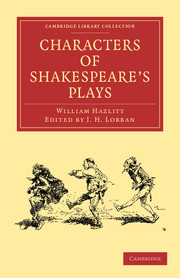Book contents
- Frontmatter
- Preface
- Contents
- Introduction
- Preface
- Cymbeline
- Macbeth
- Julius Cæsar
- Othello
- Timon of Athens
- Coriolanus
- Troilus and Cressida
- Antony and Cleopatra
- Hamlet
- The Tempest
- The Midsummer Night's Dream
- Romeo and Juliet
- Lear
- Richard II
- Henry IV
- Henry V
- Henry VI
- Richard III
- Henry VIII
- King John
- Twelfth Night; or, what you will
- The Two Gentlemen of Verona
- The Merchant of Venice
- The Winter's Tale
- All's Well That Ends Well
- Love's Labour's Lost
- Much Ado About Nothing
- As You Like It
- The Taming of the Shrew
- Measure for Measure
- The Merry Wives of Windsor
- The Comedy of Errors
- Doubtful plays of Shakespear
- Poems and Sonnets
- Notes
The Midsummer Night's Dream
Published online by Cambridge University Press: 07 September 2010
- Frontmatter
- Preface
- Contents
- Introduction
- Preface
- Cymbeline
- Macbeth
- Julius Cæsar
- Othello
- Timon of Athens
- Coriolanus
- Troilus and Cressida
- Antony and Cleopatra
- Hamlet
- The Tempest
- The Midsummer Night's Dream
- Romeo and Juliet
- Lear
- Richard II
- Henry IV
- Henry V
- Henry VI
- Richard III
- Henry VIII
- King John
- Twelfth Night; or, what you will
- The Two Gentlemen of Verona
- The Merchant of Venice
- The Winter's Tale
- All's Well That Ends Well
- Love's Labour's Lost
- Much Ado About Nothing
- As You Like It
- The Taming of the Shrew
- Measure for Measure
- The Merry Wives of Windsor
- The Comedy of Errors
- Doubtful plays of Shakespear
- Poems and Sonnets
- Notes
Summary
Bottom the Weaver is a character that has not had justice done him. He is the most romantic of mechanics. And what a list of companions he has—Quince the Carpenter, Snug the Joiner, Flute the Bellows-mender, Snout the Tinker, Starveling the Tailor; and then again, what a group of fairy attendants, Puck, Peaseblossom, Cobweb, Moth, and Mustard-seed! It has been observed that Shakespear's characters are constructed upon deep physiological principles ; and there is something in this play which looks very like it. Bottom the Weaver, who takes the lead of
“This crew of patches, rude mechanicals,
That work for bread upon Athenian stalls,”
follows a sedentary trade, and he is accordingly represented as conceited, serious, and fantastical. He is ready to undertake any thing and every thing, as if it was as much a matter of course as the motion of his loom and shuttle. He is for playing the tyrant, the lover, the lady, the lion. “He will roar that it shall do any man's heart good to hear him;” and this being objected to as improper, he still has a resource in his good opinion of himself, and “will roar you an 'twere any nightingale.” Snug the Joiner is the moral man of the piece, who proceeds by measurement and discretion in all things. You see him with his rule and compasses in his hand.
- Type
- Chapter
- Information
- Characters of Shakespeare's Plays , pp. 100 - 105Publisher: Cambridge University PressPrint publication year: 2009First published in: 1908

